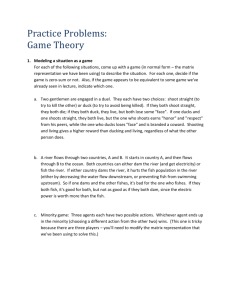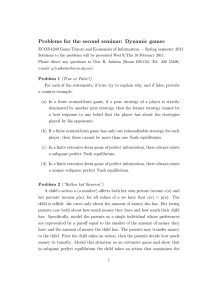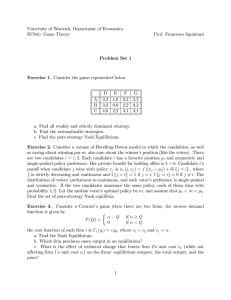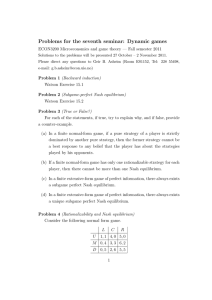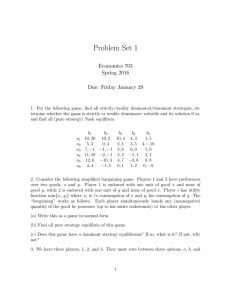Document 13383702
advertisement
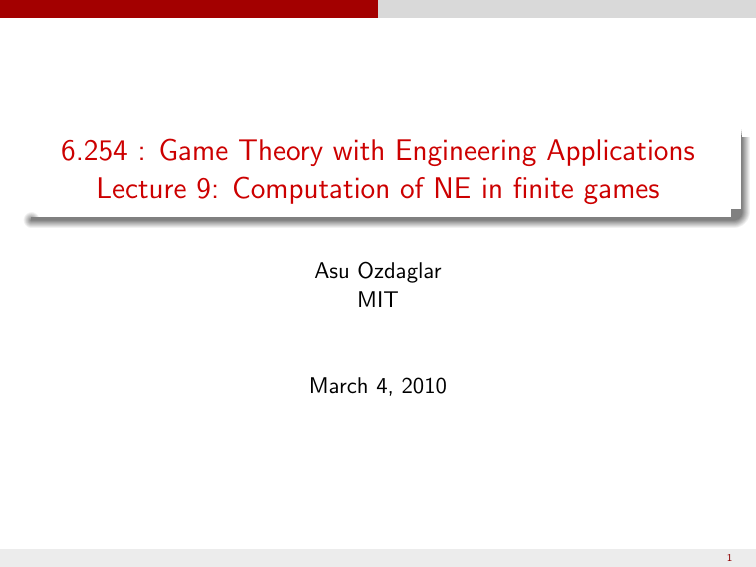
6.254 : Game Theory with Engineering Applications
Lecture 9: Computation of NE in finite games
Asu Ozdaglar
MIT
March 4, 2010
1
Game Theory: Lecture 9
Introduction
Introduction
In this lecture, we study various approaches for the computation of
mixed Nash equilibrium for finite games.
Our focus will mainly be on two player finite games (i.e., bimatrix
games).
We will also mention extensions to games with multiple players and
continuous strategy spaces at the end.
The two survey papers [von Stengel 02] and [McKelvey and
McLennan 96] provide good references for this topic.
2
Game Theory: Lecture 9
Zero-Sum Finite Games
Zero-Sum Finite Games
We consider a zero-sum game where we have two players. Assume that
player 1 has n actions and player 2 has m actions.
We denote the n × m payoff matrices of player 1 and 2 by A and B.
Let x denote the mixed strategy of player 1, i.e., x ∈ X , where
n
X = {x |
∑
xi = 1,
xi ≥ 0},
i =1
and y denote the mixed strategy of player 2, i.e., y ∈ Y , where
m
Y = {y |
∑ yj = 1,
yj ≥ 0}.
j =1
Given a mixed strategy profile (x, y ), the payoffs of player 1 and player 2
can be expressed in terms of the payoff matrices as,
u1 (x, y ) = x T Ay ,
u2 (x, y ) = x T By .
3
Game Theory: Lecture 9
Zero-Sum Finite Games
Zero-Sum Finite Games
Recall the definition of a Nash equilibrium: A mixed strategy profile (x ∗ , y ∗ )
is a mixed strategy Nash equilibrium if and only if
(x ∗ )T Ay ∗ ≥ x T Ay ∗ ,
(x ∗ )T By ∗ ≥ (x ∗ )T By ,
for all x ∈ X ,
for all y ∈ Y .
For zero-sum games, we have B = −A, hence the preceding relation
becomes
(x ∗ )T Ay ∗ ≤ (x ∗ )T Ay ,
for all y ∈ Y .
Combining the preceding, we obtain
x T Ay ∗ ≤ (x ∗ )T Ay ∗ ≤ (x ∗ )T AY ,
for all x ∈ X , y ∈ Y ,
i.e., (x ∗ , y ∗ ) is a saddle point of the function x T Ay defined over X × Y .
Note that a vector (x ∗ , y ∗ ) is a saddle point if x ∗ ∈ X , y ∗ ∈ Y , and
sup x T Ay ∗ = (x ∗ )T Ay ∗ = inf (x ∗ )T Ay .
x ∈X
y ∈Y
(1)
4
Game Theory: Lecture 9
Zero-Sum Finite Games
Zero-Sum Finite Games
For any function φ : X × Y �→ R, we have the minimax inequality:
sup inf φ(x, y ) ≤ inf sup φ(x, y ),
x ∈X y ∈Y
y ∈Y x ∈X
(2)
Proof: To see this, for every x̄ ∈ X , write
inf φ(x̄, y ) ≤ inf sup φ(x, y )
y ∈Y
y ∈Y x ∈X
and take the supremum over x̄ ∈ X of the left-hand side.
Eq. (1) implies that
inf sup x T Ay ≤ sup x T Ay ∗ = (x ∗ )T Ay ∗ = inf (x ∗ )T Ay ≤ sup inf x T Ay ,
y ∈Y x ∈X
y ∈Y
x ∈X
x ∈X y ∈Y
which combined with the minimax inequality [cf. Eq. (2)], proves that
equality holds throughout in the preceding.
Hence, a mixed strategy profile (x ∗ , y ∗ ) is a Nash equilibrium if and only if
(x ∗ )T Ay ∗ = inf sup x T Ay = sup inf x T Ay .
y ∈Y x ∈X
x ∈X y ∈Y
We refer to (x ∗ )T Ay ∗ as the value of the game.
5
Game Theory: Lecture 9
Zero-Sum Finite Games
Zero-Sum Finite Games
We next show that finding the mixed strategy Nash equilibrium strategies
and the value of the game can be written as a pair of linear optimization
problems.
For a fixed y , we have
max x T Ay = max {[Ay ]i },
x ∈X
i =1,...,n
and therefore
min max x T AY
y ∈Y x ∈X
=
=
min max{[Ay ]1 , . . . , [Ay ]n }
y ∈Y
min
y ∈Y , v 1n ≥Ay
v.
Hence, the value of the game and the Nash equilibrium strategy of player 2
can be obtained as the optimal value and the optimal solution of the
preceding linear optimization problem.
6
Game Theory: Lecture 9
Zero-Sum Finite Games
Zero-Sum Finite Games
Similarly, we have
max min x T Ay
x ∈X y ∈Y
= max min{[AT x ]1 , . . . , [AT x ]m }
x ∈X
=
max
x ∈ X , ξ 1m ≤ A T x
ξ.
Linear optimization problems can be solved efficiently (in time polynomial in
m and n).
We next discuss alternative approaches for computing the mixed Nash
equilibrium of two-player nonzero-sum finite games.
7
Game Theory: Lecture 9
Nonzero-Sum Finite Games
Nonzero-Sum Finite Games
Solution of Algebraic Equations:
We first consider an inner or totally mixed Nash equilibrium (x ∗ , y ∗ ), i.e.,
xi∗ > 0 for all i and yj∗ > 0 for all j (all pure strategies are used with
positive probability).
Let ai denote the rows of payoff matrix A and bj denote the columns of
payoff matrix B.
Using the equivalent characterization of a mixed strategy Nash equilibrium
(i.e., all pure strategies in the support of a Nash equilibrium strategy yields
the same payoff, which is also greater than or equal to the payoffs for
strategies outside the support), we have
a1 y ∗ = ai y ∗ ,
∗ T
∗ T
(x ) b1 = (x ) bj ,
i = 2, . . . , n,
j = 2, . . . , m.
The preceding is a system of linear equations which can be solved efficiently.
(Note that for more than two players, we will have polynomial equations.)
8
Game Theory: Lecture 9
Nonzero-Sum Finite Games
Nonzero-Sum Finite Games
However, the assumption that every strategy is played with positive
probability is a very restrictive assumption. Most games do not have totally
mixed Nash equilibria.
For such games, we can use the preceding characterization to come up with
a naive way to compute all the Nash equilibria of a finite two-player game:
A mixed strategy profile (x ∗ , y ∗ ) ∈ X × Y is a Nash equilibrium with
support S¯ 1 ⊂ S1 and S¯ 2 ⊂ S2 if and only if
u = ai y ∗ ,
∗ T
v = (x ) bj ,
xi∗ = 0,
∀ i ∈ S̄1 ,
∀ j ∈ S̄2 ,
∀i∈
/ S¯ 1 ,
u ≥ ai y ∗ ,
∀i∈
/ S̄1 ,
∗ T
v ≥ ( x ) bj , ∀ j ∈
/ S̄2 ,
∗
¯
yj = 0, ∀ j ∈
/ S2 .
To find the right supports for the above procedure to work, we need to
search over all possible supports. Since there are 2n+m different supports,
this procedure leads to an exponential complexity in the number of pure
strategies of the players.
Remark: Computational complexity of computing Nash equilibrium for finite
games lies in finding the right support sets.
9
Game Theory: Lecture 9
Nonzero-Sum Finite Games
Nonzero-Sum Finite Games
Optimization Formulation:
A general method for the solution of a bimatrix game is to transform it into
a nonlinear (in fact, a bilinear) programming problem, and to use the
techniques developed for solutions of nonlinear programming problems.
Proposition
A mixed strategy profile (x ∗ , y ∗ ) is a mixed Nash equilibrium of the bimatrix
game (A, B ) if and only if there exists a pair (p ∗ , q ∗ ) such that (x ∗ , y ∗ , p ∗ , q ∗ ) is
a solution to the following bilinear programming problem:
maximize
subject to
{x T Ay + x T By − p − q }
Ay ≤ p1n ,
∑ xi = 1,
i
T
B x ≤ q1m ,
(3)
(4)
∑
yj = 1,
j
x ≥ 0, y ≥ 0,
(5)
where 1n (1m ) denotes the n (m)-dimensional vector with all components equal
to 1.
10
Game Theory: Lecture 9
Nonzero-Sum Finite Games
Proof
Assume first that (x ∗ , y ∗ ) is a Nash equilibrium.
For any feasible solution of problem (3) (x, y , p, q ), the constraints (4)
imply that
x T Ay + x T By − p − q ≤ 0.
p∗
(x ∗ )T Ay ∗
q∗
(x ∗ )T By ∗ .
(6)
(x ∗ , y ∗ , p ∗ , q ∗ )
Let
=
and
=
Then the vector
has an optimal value equal to 0. If the vector (x ∗ , y ∗ , p ∗ , q ∗ ) is also feasible,
it follows by Eq. (6) that it is an optimal solution of problem (3).
Since (x ∗ , y ∗ ) is a Nash equilibrium, we have
(x ∗ )T Ay ∗ ≥ x T Ay ∗ ,
∀x ∈ X .
Choosing x = ei , i.e., the i th unit vector, which has all 0s except a 1 in the
i th component, we obtain
p ∗ = (x ∗ )T Ay ∗ ≥ [Ay ∗ ]i ,
for each i, showing that (x ∗ , y ∗ , p ∗ , q ∗ ) satisfies the first constraint in (4).
The fact that it satisfies the second constraint can be shown similarly, hence
proving that (x ∗ , y ∗ , p ∗ , q ∗ ) is an optimal solution of problem (3).
11
Game Theory: Lecture 9
Nonzero-Sum Finite Games
Proof
Conversely, assume that (x,
¯ y¯ , p,
¯ q¯ ) is an optimal solution of problem (3).
Since all feasible solutions have nonpositive optimal value [see Eq. (6)], and
any mixed strategy Nash equilibrium (which exists by Nash’s Theorem) was
shown to have an optimal value equal to 0, it follows that
x¯ T Ay¯ + x¯ T B y¯ − p¯ − q¯ = 0.
(8)
For any x ≥ 0 with ∑i xi = 1 and y ≥ 0 with ∑j yj = 1, the constraints in
(4) imply that
x T Ay¯ ≤ p̄,
y T B T x¯ ≤ q̄.
In particular, we have x¯ T Ay¯ ≤ p¯ and y¯ T B T x¯ ≤ q.
¯ Combining with Eq. (8),
we obtain x¯ T Ay¯ =
p¯ and y¯ T B T x¯ =
q.
¯
Together with the preceding set of equations, this yields
x T Ay¯ ≤ x¯ T Ay¯ ,
y T B T x¯ ≤ y¯ T B T x,
¯
for all x ∈ X ,
for all y ∈ Y .
12
Game Theory: Lecture 9
Nonzero-Sum Finite Games
Nonzero-Sum Finite Games
Linear Complementarity Problem Formulation
Recall that ai denotes the rows of the payoff matrix of player 1 A, and bj
denotes the columns of the payoff matrix of player 2.
Then, the mixed strategy profile (x, y ) ∈ X × Y is a Nash equilibrium if and
only if
xi > 0 → ai y = max ak y ,
k
yj > 0
→
T
x bj = max x T bk .
k
By introducing the additional variables ri ∈ Rn , ri ≥ 0 for i = 1, 2 (i.e.,
slack variables), and vi ∈ R, for i = 1, 2, we can write the preceding
equivalently as
Ay + r1 = v1 1n ,
B T x + r2 = v2 1m ,
T
x r1 = 0,
y T r2 = 0.
Since x ≥ 0, y ≥ 0, and ri ≥ 0, the last equation also implies that x1 r1i = 0
for all i = 1, . . . , n and yj r2,j = 0.
13
Game Theory: Lecture 9
Nonzero-Sum Finite Games
Nonzero-Sum Finite Games
Assume now that v1 > 0 and v2 > 0 (which holds if all components of A
and B are positive).
We normalize the variables y and r1 by v1 , and x and r2 by v2 and use the
notation
z = [x, y ]T , r = [r1 , r2 ]T , q = [1n , 1m ]T ,
�
�
0 A
U=
.
BT 0
If we further drop the constraints ∑i xi = 1 and ∑j yj = 1 (at the expense
of having an additional extraneous solution z = [0, 0]T ), we obtain the
following linear complementarity problem formulation
Uz + r = q,
z ≥ 0, r ≥ 0,
(9)
z T r = 0.
The last condition is referred to as the complementary slackness or the
complementarity condition.
14
Game Theory: Lecture 9
Nonzero-Sum Finite Games
Extensions
The formulations for nonzero-sum games we have discussed before
can be generalized to multiple-player finite games.
Recent work [Parrilo 06] has focused on two person zero-sum games
with continuous strategy spaces and some structure on the payoff
functions, and has shown that the equilibrium strategies and the value
of the game can be obtained efficiently.
Some of these results were extended by [Stein, Ozdaglar, Parrilo 08]
to nonzero sum games.
15
Game Theory: Lecture 9
Nonzero-Sum Finite Games
Computing Approximate Nash Equilibria
We next study a quasi-polynomial algorithm for computing an �-Nash
equilibrium.
We follow the development of [Lipton, Markakis, and Mehta 03].
Our focus will be on games with two players, in which both players have the
same number of strategies n. We denote the n × n payoff matrices of
players 1 and 2 by A and B, respectively.
The next definition captures the notion of “simple mixed strategies”.
Definition
A mixed strategy of player i is called k-uniform if it is the uniform distribution on
a subset S¯ i of the pure strategies Si with |S¯ i | = k.
For example, for a player with 3 pure strategies both x = [1/3, 1/3, 1/3] and
x = [2/3, 1/3, 0] are 3-uniform strategies.
16
Game Theory: Lecture 9
Nonzero-Sum Finite Games
Computing Approximate Nash Equilibria
Recall the definition of an �-equilibrium.
Definition
Given some scalar � > 0, a mixed strategy profile (x,
¯ y¯ ) is an �-equilibrium if
x T Ay¯ ≤ x¯ T Ay¯ + �
for all x ∈ X ,
x¯ T By ≤ x¯ T B y¯ + �
for all y ∈ Y .
The next theorem presents the main result.
17
Game Theory: Lecture 9
Nonzero-Sum Finite Games
Computing Approximate Nash Equilibria
Theorem
Assume that all the entries of the matrices A and B are between 0 and 1. Let
(x ∗ , y ∗ ) be a mixed Nash equilibrium and let � > 0. For all k ≥ 32logn
, there
�2
exists a pair of k-uniform strategies (x,
¯ y¯ ) such that
(
x̄, y¯ ) is an �-equilibrium.
�
�
� T
�
�x¯ Ay¯ − (x ∗ )T Ay ∗ � < �, i.e., player 1 gets almost the same payoff as in
the Nash equilibrium.
�
�
� T
�
�x̄ B y¯ − (x ∗ )T By ∗
� < �, i.e., player 2 gets almost the same payoff as in
the Nash equilibrium.
The proof relies on a probabilistic sampling argument. This theorem establishes
the existence of a k − uniform mixed strategy profile (x,
¯ y¯ ), which not only forms
an �-Nash equilibrium, but also provide both players a payoff � close to the
payoffs they would obtain at some Nash equilibrium.
18
Game Theory: Lecture 9
Nonzero-Sum Finite Games
Computing Approximate Nash Equilibria
Corollary
Consider a 2-player game with n pure strategies for each player. There exists an
algorithm that is quasi-polynomial in n for computing an �-Nash equilibrium.
Let k ≥ 32logn
.
�2
By an exhaustive search, we can find all k − uniform mixed strategies for
each player.
Verifying �-equilibrium condition is easy since we need to check only
deviations to pure strategies.
The running time of the algorithm is quasi-polynomial, i.e., nO (log n) since
�
�2
n+k −1
there are
≈ nk possible pairs of k-uniform strategies.
k
19
Game Theory: Lecture 9
Nonzero-Sum Finite Games
Basar T. and Olsder G. J., Dynamic Noncooperative Game Theory,
SIAM, Philadelphia, 1999.
Lipton R. J., Markakis E., and Mehta A., “Playing large games using
simple strategies,” ACM Conference in Electronic Commerce, pp.
36-41, 2003.
McKelvey R. D. and McLennan A., “Computation of Equilibria in
Finite Games,” in Handbook of Computational Economics, vol. I, pp.
87-142, Elsevier, 1996.
Parrilo P. A., “Polynomial games and sum of squares optimization,”
Proc. of CDC, 2006.
Stein N. D., Ozdaglar A., and Parrilo P. A., “Separable and low-rank
games,” to appear in International Journal of Game Theory, 2008.
Von Stengel B., “Computing equilibria for two-person games,” in R. J.
Aumann and S. Hart editors, Handbook of Game Theory, vol. 3,
chapter 45, pp. 1723-1759, Amsterdam, 2002.
20
MIT OpenCourseWare
http://ocw.mit.edu
6.254 Game Theory with Engineering Applications
Spring 2010
For information about citing these materials or our Terms of Use, visit: http://ocw.mit.edu/terms.



